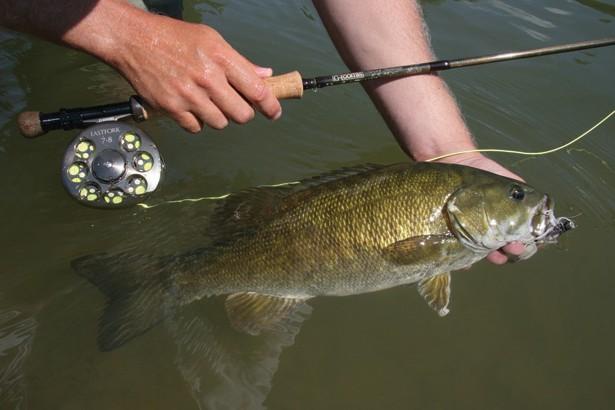Advertisement
I once heard an angler describe river-dwelling smallmouth bass as dumber, hungrier trout. He wasn’t entirely wrong—if you target river smallies the same way you go after trout, you’ll catch fish. But you’ll land even more if you understand a few key differences between bass and trout, and adapt your methods accordingly.
The fish
Advertisement
In many ways, smallmouth bass almost seem purpose-built for summer fly rodding. For starters, they’re plentiful. You’ll find smallies in just about any medium or large river within their distribution range, including the lower, slower—and frequently deserted—reaches of many prime trout streams.
Unlike stillwater bass, which are most active during summer’s shoulder hours, river dwellers will feed actively all day long, even on the surface. And while you can certainly find very large smallmouths in moving water, even a 10- or 12-incher will run, tail walk and generally tussle well above its weight.
The locations
Advertisement
All bass are opportunistic ambush predators. This is vital for understanding their habits in moving water. A trout will occupy a single prime lie such as a current seam all day long, darting out to grab snacks that drift by. But smallmouth are more aggressive, open-minded diners—and less cautious—apt to roam around trying out different hunting spots. Look for any place a bass might set up an ambush: rocky pools below cliffs, drift piles, rock ledges, weedlines and so on. Smallies particularly love hunting minnows and crayfish in broad, shallow tail-outs, especially in low-light conditions.
Although bass could be in any of these spots, there’s no guarantee they will be. Rather than spending an hour flogging each pool to death, it’s better to briefly fish all the likely spots, then keep moving until you find active fish. On bigger rivers, drifting in a small boat is often ideal. And when wading, be prepared to walk a lot of water.
Advertisement
The presentation
If you’ve ever fished moving water, you already know how to present a bass fly. In fact, river fishing for smallmouths is a great time to work on the basics, such as swinging a streamer across and downstream, dead-drifting chunky nymphs and drift-skittering surface flies. And the tackle couldn’t be simpler: string up any four- to seven-weight outfit with floating line and a rod’s length of six-pound monofilament for a leader, and you’re ready to go.
Since bass will eat just about anything—minnows, insects, crayfish, frogs and leeches—your fly doesn’t really have to look like anything in particular. It just needs to look alive. Think about the plastic baits that hardware chuckers use—pick nymphs and streamers with materials that likewise flash in the water. A small selection of the classics will suffice, ranging from size 10 up to size 2. That may seem large, but if a spin fisherman can toss a four-inch tube jig, there’s no reason you can’t use a similarly sized Clouser.
I also carry a few husky dry flies, usually Wulffs, Stimulators and my old-timey favourite, the Irresistible. Years ago, I also learned that foam or deer-hair popping bugs are absolutely lethal in moving water. True opportunists, bass will whack a garish chartreuse popper sporting a long slinky tail and wiggly legs—even if they’re already intently sipping small emergers. After all, would you continue nibbling veggie sticks if someone offered you a slice of cake?
We fly anglers can sometimes be a little fixated on details, but if there’s a guiding principle for river bassing, it’s this: Relax, don’t sweat the small stuff and have fun. Sounds like summer to me.

